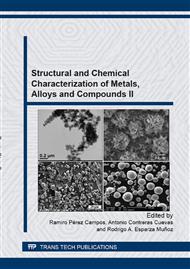[1]
F. Franzon, M. Milani, L. Montorsi and V. Golovitchev, Combined hydrogen production and power generation from aluminum combustion with water: Analysis of the concept, International Journal of Hydrogen Energy 35 (2010) 1548-1559.
DOI: 10.1016/j.ijhydene.2009.11.107
Google Scholar
[2]
E. García de León M., O. Téllez-Vázquez, C. Patiño-Carachure and G. Rosas, DSC-TGA hydrogen evaluation during mechanical milling of AlFe intermetallic, Materials Science Forum 755 (2013) 105-110.
DOI: 10.4028/www.scientific.net/msf.755.105
Google Scholar
[3]
B. Sakintuna, F. Lamari-Darkrim, and M. Hirscher, Metal hydride materials for solid hydrogen storage: A review, International Journal of Hydrogen Energy 32 (2007) 1121-1140.
DOI: 10.1016/j.ijhydene.2006.11.022
Google Scholar
[4]
X.Y. Cheng, G.W. Lin, and H.G. Li, Effect of atomic ordering on the hydrogen-induced environmental embrittlement of Ni4Mo intermetallics, Intermetallics 13 (2005) 289-294.
DOI: 10.1016/j.intermet.2004.07.016
Google Scholar
[5]
U. Prakash, N. Parvathavarthini, and R.K. Dayal, Effect of composition on hydrogen permeation in Fe-Al alloys, Intermetallics 15 (2007) 17-19.
DOI: 10.1016/j.intermet.2006.02.002
Google Scholar
[6]
J. Petrovic and G. Thomas, A study of issues related to the use of aluminum for-On-board vehicular hydrogen storage, U.S. Department of Energy version 1.0 (2008) 1-26.
Google Scholar
[7]
C. Patiño-Carachure, E. García-De León, C. Angeles-Chávez, R. Esparza, and G. Rosas-Trejo, Hydrogen embrittlement assisted by ball-milling to obtain AlCuFe nanoparticles, Journal of Non-Crystalline Solids 355 (2009) 1713-1718.
DOI: 10.1016/j.jnoncrysol.2009.06.019
Google Scholar
[8]
C.T. Liu, Recent advances in ordered intermetallics, Materials Chemistry and Physics 42 (1995) 77-86.
Google Scholar
[9]
E. Pouillier, A.-F. Gourgues, D. Tanguy, and E.P. Busso, A study of intergranular fracture in an aluminium alloy due to hydrogen embrittlement, International Journal of Plasticity 34 (2012) 139-153.
DOI: 10.1016/j.ijplas.2012.01.004
Google Scholar
[10]
B.S.J. Kang, and R. Cisloiu, Evaluation of fracture behavior of iron aluminides, Theoretical and Applied Fracture Mechanics 45 (2006) 25-40.
DOI: 10.1016/j.tafmec.2005.11.008
Google Scholar
[11]
W. Cheng-Chuan, C. Ya-Ching, and Y. Chia-Ying, Hydrogen generation from Aluminum and aluminum alloys powder, Procedia Engineering 36 (2012) 105-113.
DOI: 10.1016/j.proeng.2012.03.017
Google Scholar
[12]
J. Macanás, L. Soler, A.M. Candela, M. Muñoz, and J. Casado, Hydrogen generation by aluminum corrosion in aqueous alkaline solutions of inorganic promoters: The AlHidrox process, Energy 36 (2011) 2493-2501.
DOI: 10.1016/j.energy.2011.01.041
Google Scholar
[13]
A.V. Parmuzina, O.V. Kravchenko, Activation of aluminum metal to evolve hydrogen from water, International Journal of Hydrogen Energy 33 (2008) 3073-3076.
DOI: 10.1016/j.ijhydene.2008.02.025
Google Scholar
[14]
H.Z. Wang, D.Y.C. Leung, M.K.H. Leung, M. Ni, A review on hydrogen production using aluminum and aluminum alloys, Renewable and Sustainable Energy Reviews 13 (2009) 845-853.
DOI: 10.1016/j.rser.2008.02.009
Google Scholar
[15]
J. Huot, D.B. Ravnsbæk, J. Zhang, F. Cuevas, M. Latroche, T.R. Jensen, Mechanochemical synthesis of hydrogen storage materials, Progress in Materials Science 58 (2013) 30-75.
DOI: 10.1016/j.pmatsci.2012.07.001
Google Scholar
[16]
F. Mei-Qiang, Fen Xu and S. Li-Xian, Hydrogen generation by hydrolysis reaction of ball-milled Al-Bi alloys, Energy & Fuels 21 (2007) 2294-2298.
DOI: 10.1021/ef0700127
Google Scholar
[17]
E. García de León, O. Téllez-Vázquez, C. Patiño-Carachure, C. Ángeles-Chávez, G. Rosas, Evaluation of hydrogen embrittlement in FeAl assisted by mechanical milling, Acta Microscopica 22 (2013) 262-268.
DOI: 10.4028/www.scientific.net/msf.755.105
Google Scholar
[18]
R. N. Corby and P.J. Black, The structure of FeAI2 by anomalous dispersion methods, Acta Cryst. B29 (1973) 2669.
Google Scholar
[19]
P. J. Black, The structure of FeA13 II, Acta Cryst. 8 (1955) 175.
Google Scholar
[20]
S.S. Razavi-Tousi, J.A. Szpunar, Effect of structural evolution of aluminum powder during ball milling on hydrogen generation in aluminum water reaction, International Journal of Hydrogen Energy 38 (2013) 795-806.
DOI: 10.1016/j.ijhydene.2012.10.106
Google Scholar


